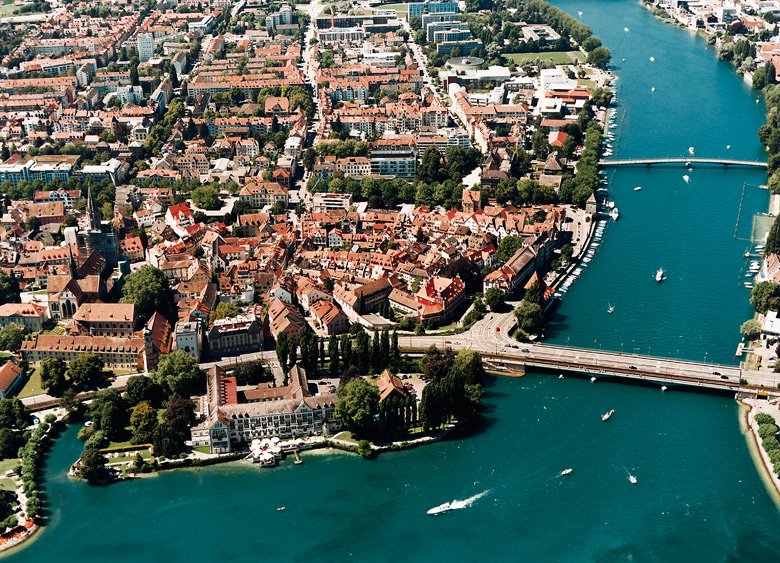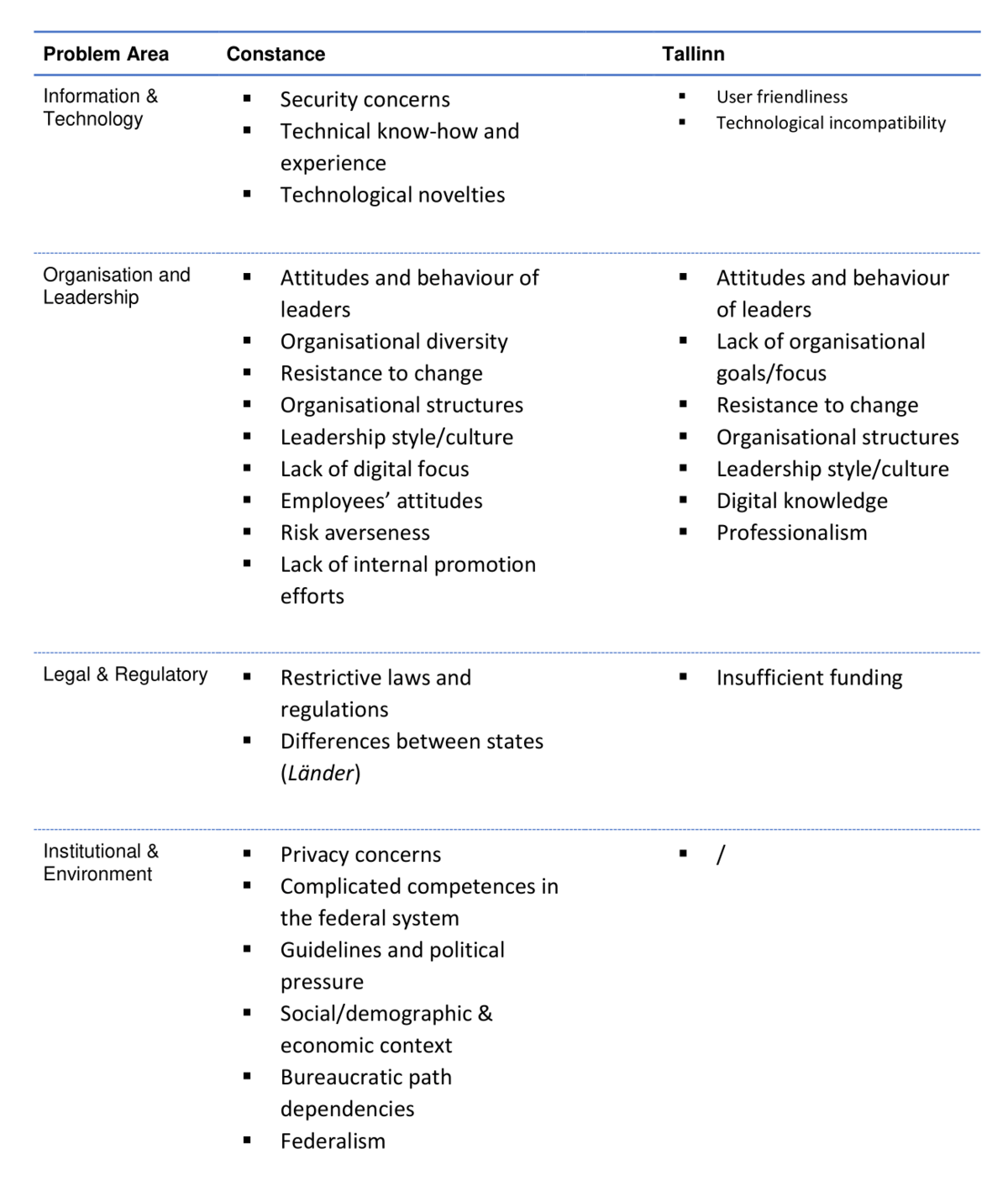
The Digital Transformation in Municipal Administrations: Problems and Strategies
Samuel Mattes and Tobias Bertermann
Summary
As the digitalisation of public administration in German is slowly getting under way, Estonia is often used as a reference point for how the digital transformation can be managed successfully. While the implementation of digital administration in Estonia seems to have taken place in record time, however, there appear to be greater hurdles to overcome for Germany. The aim of our research paper was to compare the digital transformation in German and Estonian city administrations in order to find out which different barriers occur and which strategies can be useful during the implementation phase to overcome them. To this end, we conducted a total of four interviews with experts from the city administrations of Constance (GER) and Tallinn (EST). In both cases, problems in the digital transformation process occurred primarily in the areas of organisation and management, whereas information and data problems in both countries did not play a big role. For the German administration, the identified implementation problems relate mainly to the difficulty of creating digital awareness among administrative staff. Moreover, the special German "administrative history" and its bureaucratic structures are perceived as an additional obstacle to digitalisation. The young Estonian administrative structures prove to be more flexible. Promising strategies for improved implementation in both countries were identified, such as increased transparency through better communication and improved marketing of digitalisation within the administration.
Introduction
Due to their limited financial resources and expertise, it is important for public administrations to identify relevant success factors for the digital transformation and to anticipate potential problems at an early stage in order to be able to act appropriately. While Estonia, as a founding member of the D7 group of digital nations, claims to offer its citizens digital access to 99% of its administrative processes, the digitisation of the administration in Germany is still in its infancy. The transformation process in Estonia is generally regarded as a success story, whereas in Germany strategies and solutions are currently being sought to tackle the problems of the digital transformation.
Against this background, we have set out to search for factors and strategies that can be applied in Germany and beyond. To this end, we asked public managers from the Estonian capital Tallinn and the German city of Constance what they thought were barriers to digital transformation in their own administrations and what strategies they consider helpful in countering them.
E-government and its acceptance by public administration employees are largely unexplored research questions (cf. Dukic et al., 2018). Nevertheless, a number of potential challenges and strategies of e-government are mentioned in the relevant research literature. We used these as a starting point to guide our empirical analysis and classify our own results. While barriers have been identified in the relevant literature, proposed strategies are often not sufficiently linked to specific challenges and rarely account for their complexity, especially in the public sector.
Method
To learn more about potential successful strategies, we interviewed two experts in the Estonian city administration of Tallinn and two in the German city administration of Constance in semi-structured interviews. In doing so, we sought to combine existing academic research with experiences from practitioners in order to develop our own categorisation of challenges and strategies for public administration in the context of digitisation. In addition, our research design allowed for a cross-country comparison, contrasting two countries whose successes in digital transformation show clear differences. In order to achieve the most realistic answers possible, we conducted interviews in narrative form and deliberately used open questions. We interviewed two managers from each city, one working with IT and one working with the organisational aspects of digitalisation. Using a qualitative content analysis according to Mayring (2015), we subsequently analysed the interviews. We used the deductively gained categories from the existing literature as a preliminary category system and expanded it by means of inductive category formation to include our newly gained findings.
Results
Our research has shown both similarities and differences between the transformation processes in Constance and Tallinn. Three areas of challenges for municipal administrations emerged from our interviews: the reorganization of organizational structures, the preparation of the workforce for digitalisation, and the overcoming of legal and institutional obstacles.
Reorganisation of organisational structures
All four experts emphasised the need to adapt internal organisational structures in addition to digitalising individual processes. The digital transformation both eliminates various work steps and creates new processes. However, our Konstanz experts emphasised that the German administrative history in particular stood in the way of this adaptation process, as a result of which a rather rigid organisational structure had developed. This allows them to carry out individual projects but also makes it difficult to adapt the structure as a whole.
The realisation that individual projects are easier to implement than to change structures is also reflected in the strategies mentioned for overcoming problems in the areas of organisation and management. These strategies were primarily aimed at improving individual projects rather than at structural readjustment.
In addition, all four experts stated that they used strategic outsourcing and public-private partnerships to exploit the potential for process optimisation through external expertise. For the Estonian experts, this was also a strategy to deal with limited public funds.
Preparing the workforce for the digital transformation
In the view of the experts from Constance, a decisive success factor was the positive attitude of managers and employees towards the digital transformation. Due to the omnipresence of digitalisation in Estonia, this did not seem to cause substantial problems in Tallinn. The Constance example, nevertheless, shows the need to explicitly demonstrate the advantages of digital transformation to less technology-oriented employees in order to prevent prejudices and to create digital awareness at all levels. Our experts from both municipalities reported that a degree of error tolerance and effective communication strategies are also crucial for a successful digital transformation.
Overcoming legal and institutional hurdles
The Estonian experts see themselves confronted with very few bureaucratic obstacles, as the relevant directives and laws can be adapted relatively easily in the event of legal or regulatory problems. The Constance administration, on the other hand, seems to be restricted in its scope for action by the legal framework conditions which cannot be changed at short notice in a rigid legal system. Legal requirements, such as the necessity of physical signatures for administrative files, often prevent the efficient digitalisation of individual processes. Complicated responsibilities in the German federal system also make access to necessary data and financial resources more difficult. In order to avoid these problems, the city administration of Constance often tries to find creative solutions within the regulatory framework.

Table 1: Barriers to the digital transformation in Germany and Estonia
Theoretical and Practical Implications
From a theoretical point of view, our results emphasise the importance of the administrative system as a crucial factor for the success of digital transformation. The more recent, much more flexible Estonian system has proven to be advantageous for the implementation of digitisation processes. The German system, on the other hand, which has grown over many decades, is characterised by path dependencies and is proving to be a slowing factor for municipal administrations that want to speed up their digitalisation efforts.
From a practical point of view, it is worth noting that the digital transformation must be accompanied by a holistic strategy at all levels. This includes, in particular, creating awareness among both managers and employees of the opportunities and demands of digitalisation. In addition, it is not sufficient to digitalise individual processes separately. Rather, a concerted approach at all administrative levels is necessary in order to redesign organisational structures, data streams and resource allocation in a meaningful way.
Main Points
Digital transformation can only succeed through transformative thinking at all levels. This applies not only to individual city administrations which have to prepare a fertile ground through organisational adjustments and staff management. Bold decisions are also needed at the state and federal level to create the necessary framework conditions and thereby enable the city administrations to transform. Proper coordination between the various administrative levels is therefore of vital importance in the German context.
A comparison of the two municipal administrations confirms the impression that Estonia is far ahead of Germany in the digital transformation. As one of Germany's forerunners in terms of digitalisation, the Constance city administration is confronted with a large number of different obstacles. At the same time, its ability to overcome these obstacles is limited by external conditions.
Tallinn City Council, on the other hand, benefits from its younger and more flexible organisational structure. In addition, the digital transformation in Estonia has long been a socially and politically promoted project which means that the attitudes in the population as well as the external framework conditions are already largely in harmony with the digital transformation.
Files

Samuel Mattes
has a bachelor‘s degree in Politics and Public Administration from the University of Konstanz and currently pursues a master’s degree in the same subject with a focus on management and administration as well as a special focus on methods in political and public administration sciences. He specialises in the digital transformation in public sector organisations and research on strategy and leadership.

Tobias Bertermann
has an undergraduate MA in Sustainable Development from the University of Edinburgh and currently pursues a Double Degree in European Governance at the Universities of Konstanz and Utrecht (NL). He specialises in the inter-institutional dynamics on the European level as well as environmental, energy and foreign policy.
